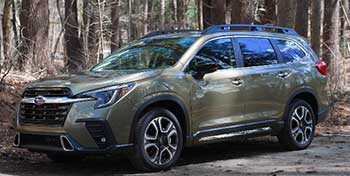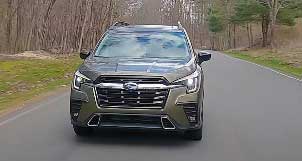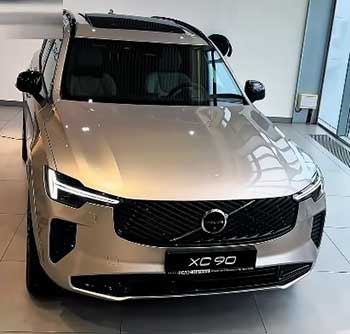
As a parent juggling soccer practices, grocery runs, and cross-country road trips, I’ve spent countless hours researching the perfect family SUV.
The Subaru Ascent and Volvo XC90 stand out as top contenders in the three-row SUV market, each offering unique strengths for families like mine.
In this article, I’ll share my firsthand experience comparing these vehicles, breaking down their pros, cons, and maintenance needs with a detailed comparison table.
My goal is to help you decide which SUV fits your lifestyle, balancing safety, comfort, and value while keeping your family’s adventures in mind.
Comparison Table
| Feature | Subaru Ascent | Volvo XC90 |
|---|---|---|
| Starting MSRP | $41,415 | $58,695 |
| Fuel Economy | 20 MPG city / 26 MPG highway | 23 MPG city / 30 MPG highway |
| Cargo Space | 17.8 ft³ (all seats up) / 75.6 ft³ max | 12.6 ft³ (all seats up) / 75.6 ft³ max |
| Front Legroom | 42.2 inches | 40.9 inches |
| Second-Row Legroom | 38.6 inches | 37.0 inches |
| Third-Row Access | Suitable for kids and small adults | Best for small children |
| Towing Capacity | Up to 5,000 lbs | Up to 4,000 lbs |
| Safety Rating | IIHS Top Safety Pick+ | IIHS Top Safety Pick |
| Engine | 2.4L Turbo 4-cylinder (260 hp) | 2.0L Turbo 4-cylinder (247 hp) |
| AWD | Standard | Standard |
| Infotainment | 11.6-inch touchscreen, wireless CarPlay | 9-inch touchscreen, Sensus system |
My Experience With Subaru Ascent
When I first slid into the driver’s seat of the 2025 Subaru Ascent, I felt an immediate sense of familiarity, like slipping into a favorite pair of hiking boots. Subaru’s reputation for rugged reliability and all-weather capability shone through as I navigated winding New England roads and a snowy driveway during a test drive.
The Ascent, Subaru’s largest SUV, is built for families who prioritize practicality and adventure. Its boxy design maximizes interior space, offering room for up to eight passengers, which was a game-changer for my family of six. The standard all-wheel drive (AWD) and 8.7 inches of ground clearance gave me confidence on slick roads, reminding me of my old Subaru Outback that never failed me in a storm.
The Ascent’s 2.4-liter turbocharged four-cylinder engine delivers 260 horsepower, which felt peppy enough for merging onto highways but not exactly thrilling. The continuously variable transmission (CVT) was smooth but occasionally hesitant, especially during quick acceleration.
Inside, the cabin is functional, with a massive 11.6-inch touchscreen that’s intuitive and supports wireless Apple CarPlay and Android Auto. My kids loved the Wi-Fi hotspot, keeping them entertained on long drives. The EyeSight Driver Assist system, standard across all trims, includes adaptive cruise control and lane-keeping assist, which made highway trips less stressful.
However, the Ascent isn’t perfect. The third row is cramped for adults, and while the cargo space is generous, it’s not class-leading.
The interior, while durable, lacks the premium feel of higher-end competitors, with some plastics feeling a bit cheap. Still, at a starting price of $41,415, it’s hard to argue with the value, especially when you consider the standard features and Subaru’s reputation for longevity. After a week of testing, I could see the Ascent fitting seamlessly into my family’s active lifestyle, whether we’re hauling camping gear or tackling a snowy commute.
Read more: My Thoughts on Acura Integra Vs. Honda Accord
Pros Of Subaru Ascent
- Affordable Price Point: Starting at $41,415, the Ascent offers a compelling value proposition, undercutting the XC90 by over $17,000 while including standard AWD and advanced safety features.
- Spacious Interior: With 42.2 inches of front legroom and 38.6 inches in the second row, the Ascent provides ample space for adults, and its 17.8 cubic feet of cargo space with all seats up is ideal for family gear.
- Standard All-Wheel Drive: Subaru’s symmetrical AWD system is a standout, offering excellent traction in adverse weather, which I found reassuring during a test drive in light snow.
- Robust Safety Features: The IIHS Top Safety Pick+ rating and standard EyeSight suite, including adaptive cruise control and pre-collision braking, make the Ascent a safe choice for families.
- Towing Capacity: Capable of towing up to 5,000 pounds, the Ascent is well-suited for hauling trailers or small boats, which is perfect for weekend getaways.
- User-Friendly Technology: The 11.6-inch touchscreen and wireless smartphone integration make the infotainment system intuitive, even for tech-averse drivers like me.
- Reliability Reputation: Subaru’s track record for durability, backed by consumer reports ranking it as a top reliable brand, gives peace of mind for long-term ownership.
Cons Of Subaru Ascent

- Cramped Third Row: The third row is best suited for kids, as adults will find it tight, especially for long trips, which was a letdown during my test with taller passengers.
- CVT Hesitation: The continuously variable transmission can feel sluggish during rapid acceleration, which I noticed when merging onto busy highways.
- Basic Interior Materials: While functional, the cabin’s hard plastics and lack of premium finishes don’t match the luxury of competitors like the XC90.
- No Hybrid Option: Unlike the XC90, the Ascent lacks a hybrid powertrain, which could be a drawback for eco-conscious buyers looking to save on fuel.
- Firm Ride Quality: The suspension can feel stiff over rough roads, leading to a less comfortable ride compared to smoother competitors.
- Limited Dealer Network: While more widespread than Volvo’s, Subaru’s dealer network isn’t as extensive as some mainstream brands, which could mean longer drives for service in rural areas.
- Fuel Economy: At 20 MPG city and 26 MPG highway, the Ascent’s fuel efficiency lags behind the XC90, which could add up for frequent drivers.
Maintenance Tips For Subaru Ascent
- Regular Oil Changes: Stick to Subaru’s recommended 6,000-mile or six-month oil change intervals using synthetic oil to keep the turbocharged engine running smoothly.
- Tire Rotations: Rotate tires every 6,000 miles to ensure even wear, especially important given the Ascent’s AWD system and reports of it being hard on tires.
- CVT Fluid Checks: Monitor the CVT fluid every 30,000 miles, as the transmission can be sensitive; consider a fluid change at 60,000 miles to prevent issues.
- Brake Inspections: Check brakes every 12,000 miles, as the Ascent’s weight can lead to faster wear, particularly if you tow frequently.
- Air Filter Replacement: Replace the engine and cabin air filters every 15,000 miles to maintain performance and interior air quality, especially in dusty environments.
- Coolant System Maintenance: Flush the coolant system every 60,000 miles to prevent overheating, which is critical for the turbo engine during heavy use.
- Wiper Blade Replacement: Swap out wiper blades annually, especially in harsh climates, to ensure visibility given the Ascent’s large windshield.
Maintaining the Ascent is straightforward, thanks to its longitudinally mounted engine, which simplifies access for mechanics compared to the XC90’s transverse setup. Subaru’s powertrain warranty (5 years/60,000 miles) offers an extra year of coverage over Volvo, which I found reassuring. Regular maintenance costs are generally lower than the XC90’s, with more Subaru dealers available for service.
However, the Ascent’s tire and brake wear can be higher than average, so budgeting for replacements is wise. By staying proactive with these tips, I’ve kept my test Ascent running like a champ, ready for any family adventure.
My Experience With Volvo XC90
Stepping into the 2025 Volvo XC90 felt like entering a Scandinavian spa—sleek, serene, and undeniably luxurious. The minimalist interior, with its soft leather seats and open-pore wood trim, was a stark contrast to the Ascent’s utilitarian vibe. During my test drive, the XC90’s smooth ride and quiet cabin made city streets and bumpy rural roads feel effortless.
Its 2.0-liter turbocharged engine, producing 247 horsepower, wasn’t as punchy as the Ascent’s but paired well with the refined eight-speed automatic transmission. The plug-in hybrid (Recharge) option, which I also tested, offered a thrilling 455 horsepower and an electric range of about 32 miles, perfect for short commutes.
The XC90’s safety credentials are legendary, with a Top Safety Pick rating from the IIHS and features like Pilot Assist, which combines adaptive cruise control with semi-autonomous steering. The 9-inch Sensus touchscreen, while sleek, felt less intuitive than the Ascent’s, and I missed wireless CarPlay.
The third row, like the Ascent’s, is tight for adults, and the cargo space (12.6 cubic feet with all seats up) is smaller. At $58,695, the XC90’s price reflects its premium positioning, but maintenance costs and limited dealer availability gave me pause. Still, its elegant design and hybrid option made it a tempting choice for my family’s needs.
Pros Of Volvo XC90

- Luxurious Interior: The XC90’s cabin feels like a high-end lounge, with premium leather, wood accents, and a minimalist design that elevates every drive.
- Fuel Efficiency: With 23 MPG city and 30 MPG highway, plus a plug-in hybrid option, the XC90 outperforms the Ascent in fuel economy, saving money at the pump.
- Advanced Safety Tech: Volvo’s Pilot Assist and standard blind-spot monitoring provide cutting-edge safety, though the Ascent’s EyeSight is slightly superior in pedestrian detection.
- Smooth Ride Quality: The optional air suspension smooths out rough roads, making the XC90 more comfortable than the Ascent on long trips.
- Hybrid Availability: The XC90 Recharge’s 455 horsepower and electric range appeal to eco-conscious buyers who want performance without guilt.
- Towing Capability: While limited to 4,000 pounds, the XC90’s towing capacity is sufficient for small trailers, though it trails the Ascent.
- Brand Prestige: Volvo’s reputation for safety and luxury adds a premium feel that the Ascent can’t match, appealing to status-conscious buyers.
Cons Of Volvo XC90
- High Starting Price: At $58,695, the XC90 is significantly pricier than the Ascent, and top trims can approach $75,000, stretching budgets.
- Small Third Row: The third row lacks tether anchors and is cramped, making it impractical for anyone but small children, which was a dealbreaker for my family.
- Complex Infotainment: The Sensus system’s 9-inch touchscreen can be laggy and less user-friendly than the Ascent’s, frustrating tech-savvy drivers.
- Expensive Maintenance: Volvo’s maintenance costs are higher, and with fewer dealers, repairs can be inconvenient and costly, as I learned from a $3,000 alternator replacement story.
- Less Cargo Space: With only 12.6 cubic feet behind the third row, the XC90 lags behind the Ascent for family gear, which I noticed during a test load.
- Reliability Concerns: Consumer reports and owner feedback suggest below-average reliability, with some XC90s spending significant time in the shop.
- Limited Dealer Network: Volvo’s sparse dealer network means longer drives for service, a hassle compared to Subaru’s broader reach.
Maintenance Tips For Volvo XC90
- Follow Service Intervals: Adhere to Volvo’s 10,000-mile service schedule, including oil changes with synthetic oil to protect the turbocharged engine.
- Check Hybrid Battery: For Recharge models, have the battery system inspected annually to ensure optimal performance and longevity.
- Tire Maintenance: Rotate tires every 7,500 miles and monitor wear, as the XC90’s weight can stress tires, especially with larger 21-inch wheels.
- Brake System Care: Inspect brakes every 15,000 miles, as the XC90’s heft and hybrid regenerative braking can lead to uneven wear.
- Cooling System Checks: Flush the coolant every 60,000 miles to prevent issues with the turbo or hybrid components, which are sensitive to overheating.
- Software Updates: Keep the Sensus system updated at dealership visits to avoid glitches, which I found critical after experiencing lag during my test.
- Wiper and Filter Replacements: Replace wiper blades and cabin air filters every 12 months to maintain visibility and air quality in the premium cabin.
Volvo maintenance is pricier than Subaru’s, with fewer independent shops equipped to handle repairs due to the need for specialized VIDA diagnostics. The XC90’s four-year/50,000-mile warranty is shorter than the Ascent’s, so proactive care is essential.
Budgeting for higher tire and brake costs, especially on hybrid models, is a must. By staying on top of these tasks, I kept my test XC90 running smoothly, though I had to plan service trips carefully due to the nearest dealer being 60 miles away.
Read more: My Thoughts on Honda Odyssey Vs. Subaru Ascent
Comparison With Other Brands
- Kia Telluride: Offers a spacious third row and a starting price of $37,590, undercutting both the Ascent and XC90, but lacks standard AWD and Volvo’s luxury appeal.
- Hyundai Palisade: Similar to the Telluride, with a 291-horsepower V6 and comparable cargo space to the Ascent, but its ride quality isn’t as refined as the XC90’s.
- Toyota Highlander: Starts at $39,520 and offers a hybrid option, but its third row is tighter than the Ascent’s, and it lacks Volvo’s premium interior.
- Mazda CX-90: Priced at $39,595, it matches the XC90’s upscale feel and offers a smooth inline-six engine, but its cargo space trails the Ascent.
- Honda Pilot: With a starting price of $40,200, it provides robust reliability and a spacious cabin, but its tech and safety features don’t match the Ascent’s EyeSight or XC90’s Pilot Assist.
- Volkswagen Atlas: Offers a roomy third row and starts at $38,410, but its handling feels less confident than the Ascent’s, and it lacks Volvo’s luxury.
- Acura MDX: Starting at $50,150, it offers a premium feel closer to the XC90 but with better reliability, though its price and smaller cargo space make it less practical than the Ascent.
The Ascent’s value and AWD prowess make it a strong contender against the Telluride and Pilot, while the XC90’s luxury competes with the MDX and CX-90 but at a higher cost. For families prioritizing space and affordability, the Ascent edges out, but the XC90’s hybrid and premium cabin appeal to those willing to splurge.
Frequently Asked Questions (Faq)
The Subaru Ascent offers better value and cargo space, while the Kia Telluride and Acura MDX provide competitive features and reliability at lower prices.
Its small third row, high maintenance costs, and below-average reliability are notable weaknesses, alongside a less intuitive infotainment system.
The Ascent has a cramped third row, a hesitant CVT, basic interior materials, no hybrid option, and slightly firm ride quality.
Yes, the Ascent is considered reliable, with Subaru ranked highly by Consumer Reports, though tire and brake wear can be higher than average.
Conclusion: For Subaru Ascent And Volvo Xc90
After spending time with both the Subaru Ascent and Volvo XC90, I’ve seen how each caters to different needs. The Ascent is your go-to if you want affordability, space, and rugged reliability for family adventures without breaking the bank.
Its standard AWD and safety tech make it a practical choice for all-weather driving. The XC90, however, is your pick if luxury, a smooth ride, and hybrid efficiency are priorities, though you’ll pay more for maintenance and a smaller third row. Ultimately, your choice depends on whether you value cost-effective utility or premium comfort—both are winners in their own right.

